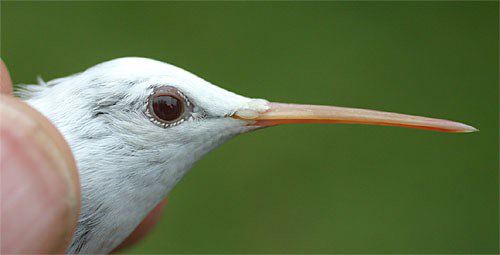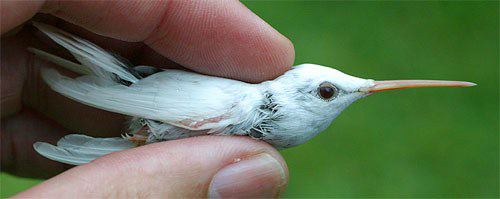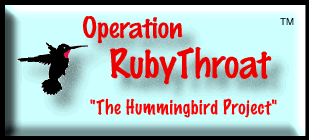|
|
|||
THIS WEEK at HILTON POND
8-14 August 2003
Installment #184 -- Visitor #
Back to Preceding Week; on to Next Week
|
|
|||
THIS WEEK at HILTON POND
8-14 August 2003
Installment #184 -- Visitor #
Back to Preceding Week; on to Next Week
|
BANDING THE ALBINO HUMMINGBIRD The first week in August 2003, Hilton Pond Center got an e-mail from Becky Laskody about a white hummingbird that since 30 July had been coming regularly to her feeder in Chapel Hill NC. She was curious whether the bird was an albino and how unusual it was to see a hummer with white plumage. Most white hummingbirds are "leucistic"--from the same root as "leukocyte" (white blood cell) and "leukemia"--and they bear light-colored feathers. Whether leucistic or albinistic, there aren't many white hummingbirds in the world. Hummer bander Ellie Womack of Grove OK compiled sightings and could find reports for about a hundred white hummingbirds among all hummers that have ever been seen; as might be expected, only a literal handful of albino Ruby-throated Hummingbirds have actually been captured and banded. Thus, when Becky Laskody e-mailed us a still photo (below right) of her white hummingbird with pale bill, we got understandably excited and laid plans to stop by Chapel Hill on 8 August while driving northward for our "Hummingbird Mornings" programs in Fredericksburg VA.
Almost immediately several white-throated Ruby-throated Hummingbirds--either females or young males with normal plumage (example, below left)--appeared and, one by one, figured how to get inside the trap for a drink of sugar water. At about the 20-minute mark, a flash of white zipped around the corner of the shed for our first look at a pure white hummingbird. Although we couldn't see the color of the eyes or feet, through binoculars it was immediately apparent that the bird had a pinkish-orange bill; there was no doubt it was indeed a rare albino, so we carefully studied the bird as it hovered outside the trap. Because the bill looked long and the body seemed big, we speculated it was a female, knowing that male Ruby-throated Hummingbirds are up to 25% smaller. In typical hummingbird fashion, the white hummer--named "Angel" by the Laskody family--tried to get at the feeder from the end of the trap opposite the trapdoor and being unsuccessful at passing through the wire mesh wall, eventually gave up and flew away. Trying to outwit this white hummer, we went out in the rain and turned the trap 180 degrees so the door opened in the direction from which the white hummer originally tried to enter. As might be expected, this trick failed miserably when the bird returned and still tried to enter the trap without using a door. After almost an hour during which it came and went and hovered around or perched on the trap, the white hummer finally flew through the open end and we hit the remote button to snare it while it drank. When we examined the trap we determined the rain guard had caught on the door and kept it from closing, so we adjusted everything and went back inside the house--with heavy heart and quite angry at technology-- knowing full well we might never see the white hummingbird again. Time began to pass very slowly. Hummers with normal plumage made dozens of visits to the trap and feeder, but no albino. Fortunately, the kids in the dining room had every confidence that sooner or later the white hummer would reappear. At about the two-hour mark, their youthful optimism was rewarded as the elusive albino cruised in and with almost no hesitation flew directly through the open door of the trap. This time the remote button worked and the door slid shut so smoothly the white hummer perched on the feeder and continued to drink. We watched for a few minutes and then went out to the trap, carefully removed the white hummer, and brought the bird in to show to the assembled multitude. As interesting as this bird was on the wing, it was even more incredible up close where we could see white plumage that almost glowed--plus a bright red eye (below) and a bill that was an indescribable, sensuous blend of orange and pink. 
All text & photos © Hilton Pond Center In one of her later e-mails to Hilton Pond Center, Becky Laskody mentioned she had noticed a dark area on the bird's rump that appeared to be a color mark of some sort. The spot had been noticeable when the bird hovered around the trap, and various observers had guessed it was a dirt smudge, a place where spider webs may have pulled off a few feathers, or where a few feathers had been lost in the normal molt process. The more we examined this unusual little hummingbird, the more fascinating it became. We noticed, for example, that the wing appeared to have a pink spot where the long primary wing feathers attached to the bird's vestigial hand (below). Again thinking it was some sort of dirt smudge, we magnified the pink area with a hand lens and it suddenly struck us that we were looking at a bare patch of unpigmented skin. This revelation led to another "Ahah! moment." When we caught the leucistic hummingbird in Anderson a few years ago (top photo), we noted it had a prominent black stripe at the bend of its wing. Ever since then we've wondered why a bird with otherwise white plumage would have a black wing spot, and now we knew: the spot on the leucistic hummer's wing was actually pigmented dark skin showing through at exactly the location that appeared pink on the albino. In the past few days we've examined several ruby-throats with normal plumage and found that same patch of dark, bare skin, so an old mystery was solved due to our capture of an albino hummingbird! Now we're wondering what the function of the bare skin--technically, a "subalular apterium"-- could be! 
All text & photos © Hilton Pond Center Despite being experienced bird banders, we were enchanted by the just-captured albino hummingbird, but we still needed to measure and band it so it could be released. First, we were interested in confirming its sex and species, both of which can be determined by close examination of wing feather shape. From this we concluded it was indeed a Ruby-throated Hummingbird, and our initial speculation that it was a female was borne out by the rounded tip of the sixth primary feather--which in male ruby-throats is tapered and sharply pointed.
We also used a magnifier to see that the bird's bill carried tiny etchings-- corrugations that occur on young birds but disappear over several months and are essentially absent from adult hummers. From this we could conclude that the albino hummer hatched in 2003 and--based on the complete lack of wear in the delicate wing and tail feathers--we believe the bird was produced locally and that Becky saw it at her feeder very soon after it fledged from its nest. After completing our measurements and carefully recording them in the banding log, we scrutinized the bird a few more times before going out to take photos. Fortunately, the rains had stopped, and it was through the 50mm macro lens of our Canon D60 digital camera that we made what was, for us, the most remarkable observation and photograph of the day. Even though everything about this particular Ruby-throated Hummingbird was gee-whizzy and exciting, the camera revealed something very special that drove home the unique nature of Becky Laskody's albino. As we focused in for a close-up of the band on the bird's tiny pink leg, we suddenly noticed the skin on the toes was completely transparent and that we could actually see the bird's blood vessels (below). Even more amazingly, the long decurved claws were also transparent--so much so that we could observe the blood-rich area at the base of the claw that allows it to grow. We now understand very clearly why it is so important not to clip the claws of a cage bird too close to the root, lest the living portion of the claw be permanently damaged. 
All text & photos © Hilton Pond Center We could have marveled over this bird for the rest of the day, but knowing many miles remained between Chapel Hill and Fredericksburg VA, we posed the bird so that Becky's son Kody could shoot some video and have something for show-and-tell when school started back.
POSTSCRIPT: Soon after we dismantled our trap and departed Chapel Hill on 8 August, the albino ruby-throat returned to the Laskody feeder.  In fact, Becky observed the white bird many times through 11 August, after which it apparently moved into another neighborhood or began migrating south for the winter. When we band a Ruby-throated Hummingbird at Hilton Pond Center we also place a green color mark on its upper breast and throat (scroll down page for photo and more info). The Chapel Hill albino was marked instead with a spot of blue dye on its breast, in case someone at another location sees it, takes a photo, and files a report without having to read its actual band number. We're hopeful this very unusual--and very visible--color-marked white hummingbird will thus provide us with information about its migration path. Curiously, no albinistic or leucistic hummingbird has ever been recaptured or found away from its original banding site, nor has one been known to return in a later year. We suspect an albino's white feathers wear out too quickly to allow a full migration, that predators easily home in on white hummers, or that these aberrant birds have a complement of genetic defects that limit their survival. In fact, Becky observed the white bird many times through 11 August, after which it apparently moved into another neighborhood or began migrating south for the winter. When we band a Ruby-throated Hummingbird at Hilton Pond Center we also place a green color mark on its upper breast and throat (scroll down page for photo and more info). The Chapel Hill albino was marked instead with a spot of blue dye on its breast, in case someone at another location sees it, takes a photo, and files a report without having to read its actual band number. We're hopeful this very unusual--and very visible--color-marked white hummingbird will thus provide us with information about its migration path. Curiously, no albinistic or leucistic hummingbird has ever been recaptured or found away from its original banding site, nor has one been known to return in a later year. We suspect an albino's white feathers wear out too quickly to allow a full migration, that predators easily home in on white hummers, or that these aberrant birds have a complement of genetic defects that limit their survival.
All text & photos © Hilton Pond Center Please send photos and reports of white hummingbirds to RESEARCH. NOTE: Be sure to scroll down for an account of all birds banded or recaptured during the week, as well as some other interesting nature notes. For lots more information about hummingbirds, click on the logo below:  "This Week at Hilton Pond" is written and photographed by Bill Hilton Jr., executive director of Hilton Pond Center for Piedmont Natural History. You may wish to consult our Index of all nature topics covered since February 2000. You can also use the on-line Search Engine at the bottom of this page. For a free, non-fattening, on-line subscription to "This Week at Hilton Pond," just send us an E-mail with Subscribe in the subject line. Please be sure to configure your spam filter to accept E-mails from hiltonpond.org. |
|
Make direct donations on-line through
Network for Good: |
|
|
LIKE TO SHOP ON-LINE?
Donate a portion of your purchase price from 500 top on-line stores via iGive: |
|
|
Use your PayPal account to make direct donations:
|
|
|
|
|
|
|
SPECIES BANDED THIS WEEK: * = New species for 2003 WEEKLY BANDING TOTAL 4 species 15 individuals
YEARLY BANDING TOTAL (2003) 46 species 767 individuals
BANDING GRAND TOTAL (since 28 June 1982) 123 species 42,881 individuals
NOTABLE RECAPTURES THIS WEEK (with original banding date, sex, and current age) Ruby-throated Hummingbird (1) |
OTHER SIGHTINGS OF INTEREST  --After banding the albino Ruby- throated Hummingbird at Chapel Hill, we drove on to Fredericksburg VA for our second year of Hummingbird Mornings presentations hosted by Steve & Bunny Maier and their Wild Bird Center store. On 9 Aug nearly 400 people came out for two 90-minute banding lecture- demonstrations, held on the banks of the Rappahannock River where free-flying Bald Eagles also put on a nice show. Our next hummer presentations will be at 8:30 and 10:30 a.m. on 16 Aug at McDowell Nature Preserve southwest of Charlotte NC, hosted by Chirp N' Chatter of Tega Cay SC. If your group is interested in hosting Hummingbird Mornings in late July, August, or early September 2004, please send us an e-mail. VAGRANT HUMMINGBIRDS None this week. |
|
Up to Top of Page Current Weather Conditions at Hilton Pond Center |
 post questions for The Piedmont Naturalist |
Join the |
Search Engine for |
|
|